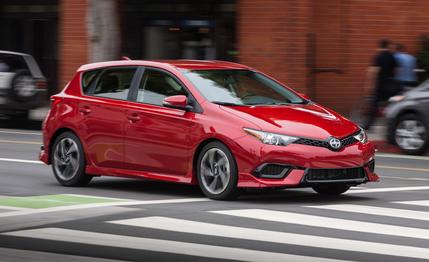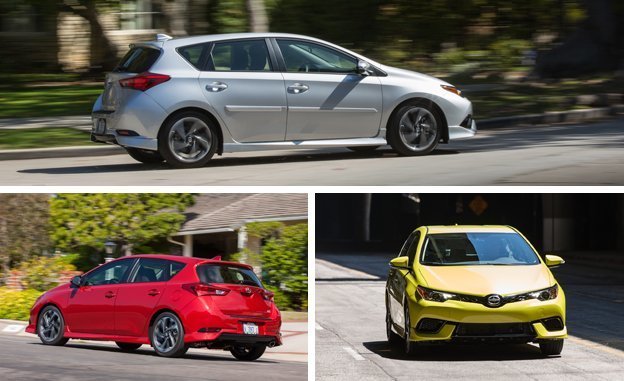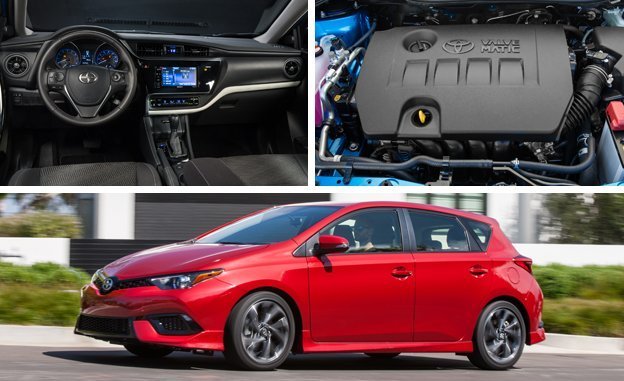
 First Drive Review
First Drive Review
Cruising down Pacific Coast Highway in a preproduction prototype automobile, you would think we’d get at least one knowing look. But we don’t. Here we are in a major hotbed of automobile culture—Los Angeles—in a car that probably no one around us has ever seen on the road, and exactly no one notices. We’re invisible.
We’re not surprised. We are in the 2016 Scion iM, after all, essentially a rebadged version of the innocuous Auris hatchback that Toyota sells in overseas markets; it’s a car that pretty much no one but Scion dealers is hungry to see. If we were in a prototype of the next Volkswagen Golf, we’d be chased down by every GTI driver within 10 miles. Were we in the next-generation Honda Civic, we’d be mobbed like the Beatles in 1964. But as it stands today, Scion has no wild-eyed following.


The iM’s story of meh starts with the styling. Scion did little to dress up the overwhelmingly trapezoidal Auris beyond adding a body kit, directional 17-inch wheels, and a bright exhaust tip. Granted, the result doesn’t hurt the eyes, but from an identity standpoint there’s little for the observer to grasp. Looking like a mix of the Toyota Corolla and the first-generation Mazda 3, the iM is neither as emotional as the current Mazda 3 nor as dapper as the Volkswagen Golf.
The all-black interior, however, is rather more enticing, yet it still fails to rise much higher than midpack in terms of design and accouterments. Like other Scions, the iM comes “mono-spec”—the only choices you make involve exterior color and transmission—and includes a fairly comprehensive amount of equipment, most of which we illuminated when we covered the iM’s launch at the 2015 New York auto show. All is arranged in a reasonably attractive, ergonomically sound design and is rendered with an unexpected amount of soft-touch surfacing, contrast stitching, and high-quality fabrics on the seats, the doors, and even the headliner. There’s a bit of over-reliance on piano-black trim to class things up, but, really, there’s little conspicuous cheapness in a segment that’s pretty full of it. We wonder, however, if the lack of available upgrades such as a sunroof or leather upholstery will cost Scion some sales, as many of its competitors are offering such amenities.
The segment is also full of cars offering better performance. Although the iM has been given a mill more powerful than anything in an Auris, a 1.8-liter four-cylinder with 137 horsepower and 126 lb-ft of torque, it is handily outmuscled by hatchbacks such as the 155-hp Mazda 3, the 160-hp Ford Focus, the 170-hp VW Golf, and the 173-hp Kia Forte 5. Furthermore, the iM’s fuel economy of 27/36 mpg city/highway with the six-speed manual (28/37 for the CVT) are merely midpack, despite the power deficit. Scion didn’t provide factory-estimated acceleration numbers, but on the mountain roads of Malibu, we had to mash the pedal much of the time, and the sound was neither stirring nor straining. It was, to use the term again, meh.


Of the two transmissions, we vastly prefer the manual, although its shift quality is nothing to get excited about. The alternative is the so-called CVTi-S, which deserves some credit for providing a Sport mode that not only revs the engine higher and more readily as it runs through its seven simulated gears, but can also, with the help of a yaw sensor, predictively raise engine revs as the car exits a corner.
Speaking of cornering, this is arguably what the iM does best. While steering feel won’t win any awards, the electrically driven rack does direct the front tires with precision. We spent a fair bit of time driving an iM that Scion fitted with the accessory TRD lowering springs, TRD anti-roll bars, and TRD air filter, and decided that all should be mandatory equipment for anyone with a pulse, as these parts reduce the car’s body motions and sharpen its response, thus making the most of the strut front/control-arm rear suspension’s capabilities.
Perhaps this car’s greatest attribute is its value, which, at the price of $19,255 for the manual and $19,995 for the automatic, will make good on Scion’s promise of a sub-$20K MSRP when it arrives in Scion dealerships (along with the Mazda 2–based iA) this fall. Adding the navigation kit for an estimated $900 and the TRD bits, we still estimate that an iM with the manual would cost less than $23,000, or roughly the starting price of a four-door VW Golf. We only wish it were a bit more interesting to look at and to drive, because if Scion is going to survive, it needs a following. And at first blush, the iM doesn’t seem good enough to build one.